One essential metric that determines the success of your campaigns is your email open rate.
But how can you encourage more people to open your emails? What even is a good open rate for your industry? Is it important for a successful digital marketing strategy?
This article explains everything you need to know about average email open rates by industry, region, and day, such as:
- What is a good open rate
- Five factors affecting your rates
- Tips for increasing them
What Is An Email Open Rate?
An email open rate is the percentage of email recipients who open a specific email out of your total number of subscribers.
Many businesses use this concept to measure the success of their email campaigns because it gives them information about the effectiveness and viability of their email marketing lists.
How to calculate your open rate?
Usually, you can calculate the email open rate based on unique opens—the first time a single subscriber opens an email while ignoring the subsequent opens by the same person.
Here’s the formula for measuring your open rates:
The purpose of email open rates is to help you pinpoint the disengaged and inactive people so you can either find solutions to win them back or clean your lists.
Similarly, you can use them to better understand how often your audience opens your emails and what content interests them. Everyone, from eCommerce store owners to real estate agencies, needs to keep track of their rate to perform optimizations.
But how can you tell which is the best email open rate? Find out the answer in the next section.
What Is A Good Email Open Rate?
A good email open rate is somewhere around 20%, but your industry highly influences it (we will see how in the next section).
For example, the highest open rate for healthcare services is 23.37%, while for retail it’s around 20.70%.
In short, having high open rates means the subject line and email content resonate with your audience.
On the other hand, the most common reasons for low open rates are:
- Bad subject lines
- Too many spam trigger words
- Lack of incentive for your recipients
- Poor marketing segmentation
- High frequency of emails or wrong timing
- Lack of personalization
Improving your campaign’s performance starts with knowing the numbers.
So, looking into your specific region or industry averages and using them as a benchmark is critical to effective marketing campaigns.
In the following sections, let’s look at email benchmarks by industry, region, and day.
Average Email Open Rate By Industry
According to Statista, there were 4 billion global email users in 2020; by 2025, this number is set to grow to 4.6 billion.
It’s no wonder many marketers prefer email over social media as their most effective marketing channel. However, savvy marketers know that the industry highly influences average email open rates.
Below, you can take a look at the following table, which includes other metrics such as unsubscribe and bounce rate, to see the average email open rate by industry:
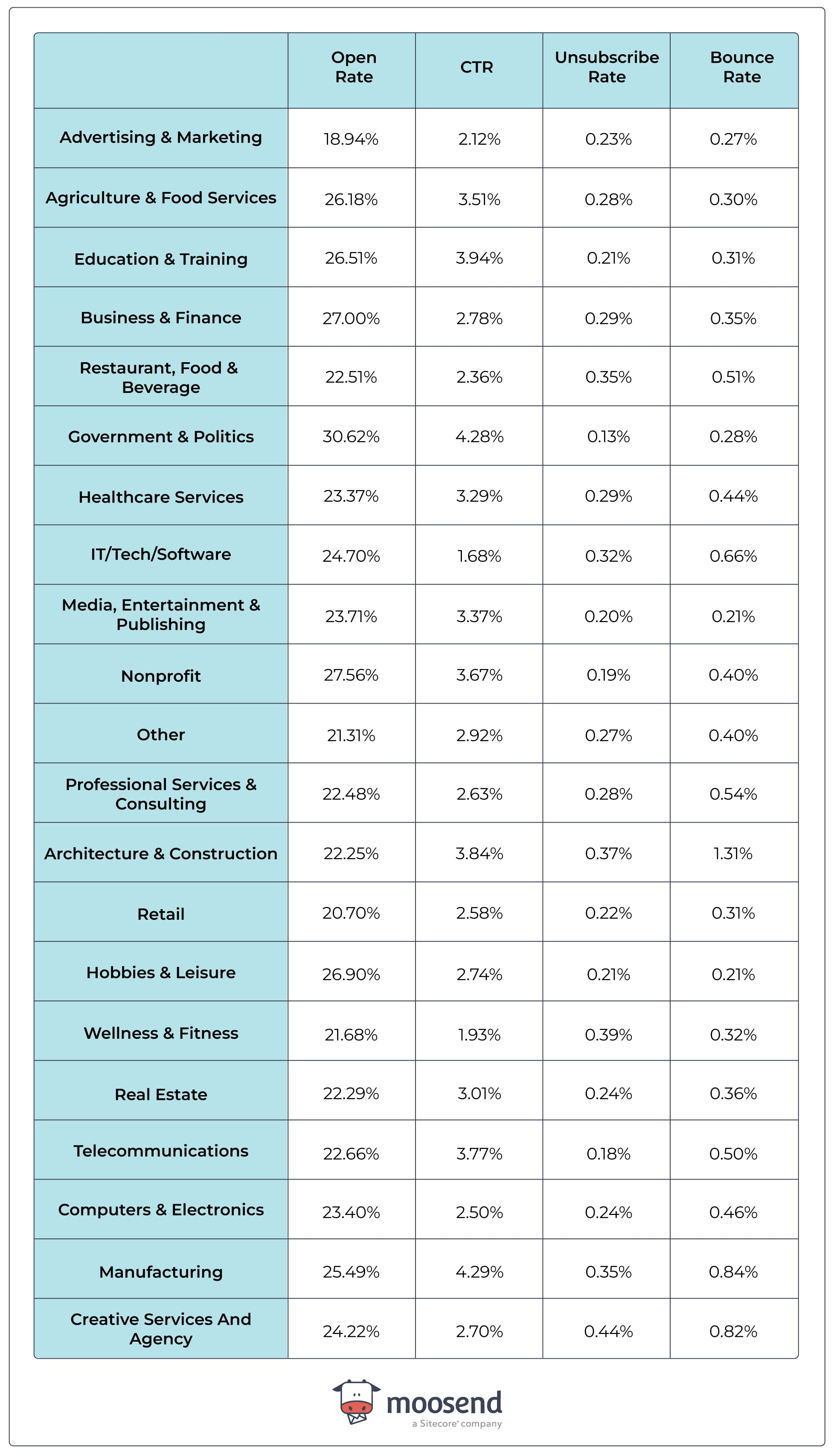
Now we can draw some conclusions based on this data:
- The Government & Politics sector has the highest open rate (30.62%), while the lowest belongs to Advertising and Marketing (18.94%).
- Other industries with higher open rates are business and finance (27%) and nonprofit organizations (27.56%), which makes sense because of the quickly changing prices worldwide.
With these useful statistics in mind, you can understand how many people actually open your emails so you can shift the focus of your marketing efforts accordingly.
Moving on, let’s discuss the average email open rates by region.
Average Email Open Rate By Region
Now that you know the average email open rate by industry, let’s explore what happens for different regions.
Based on recent data from GetResponse, let’s compare the numbers (we’ve also added other metrics):
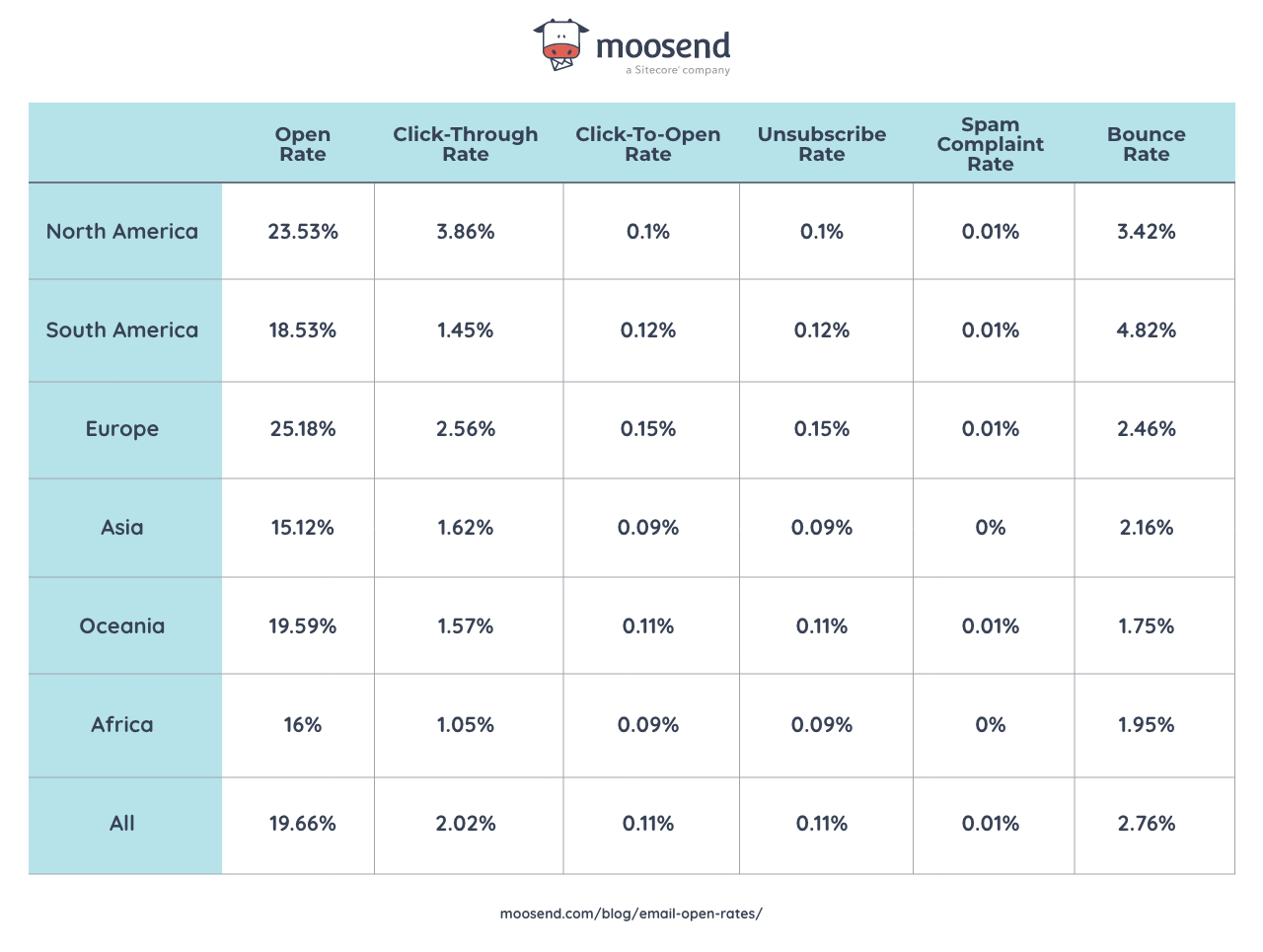
Firstly, we can see that the average email open rate is higher in areas such as Europe (25.18%) and North America (23.53%), whereas the lowest is in Asia (15.12%).
While engaging and creating content for the rest of the world is challenging, improved localization—in terms of language and cultural and social realities—can help you improve your emails’ performance.
Lastly, we’ll talk about the average email open rates by day.
Average Email Open Rate By Day
Campaign Monitor can help us determine the most effective days to send emails to your subscribers; sneak a quick peek at this table:

The differences are slight, but Monday wins in terms of average open rates, closely followed by Tuesday and Wednesday.
Not surprising is Friday’s low open rate. Everyone is already daydreaming about the weekend and rushing to go offline so they’re less likely to check their mailboxes.
This data will help you see how your current marketing campaigns perform compared to the average benchmarks.
Moving on, let’s explore other email marketing metrics related to open rates.
Other Email Marketing Metrics Related To Open Rate
While open rates are vital to ascertain the success of your campaigns, there are other metrics to keep track of if you want to take it a step further.
For now, though, we’ll explore two other valuable email metrics to assess your email marketing strategy: click-to-open rate (CTOR) and click-through rate (CTR).
Click-To-Open Rate (CTOR)
Click-to-open rate (CTOR) is the percentage of people who clicked a link or call-to-action (CTA) after opening an email compared to the total number of subscribers who opened it.
While it’s a less familiar metric, CTOR focuses on measuring engagement and highly depends on the quality of your content.
You can calculate it by dividing the total of unique clicks by the sum of unique opens, then multiplying it by 100.
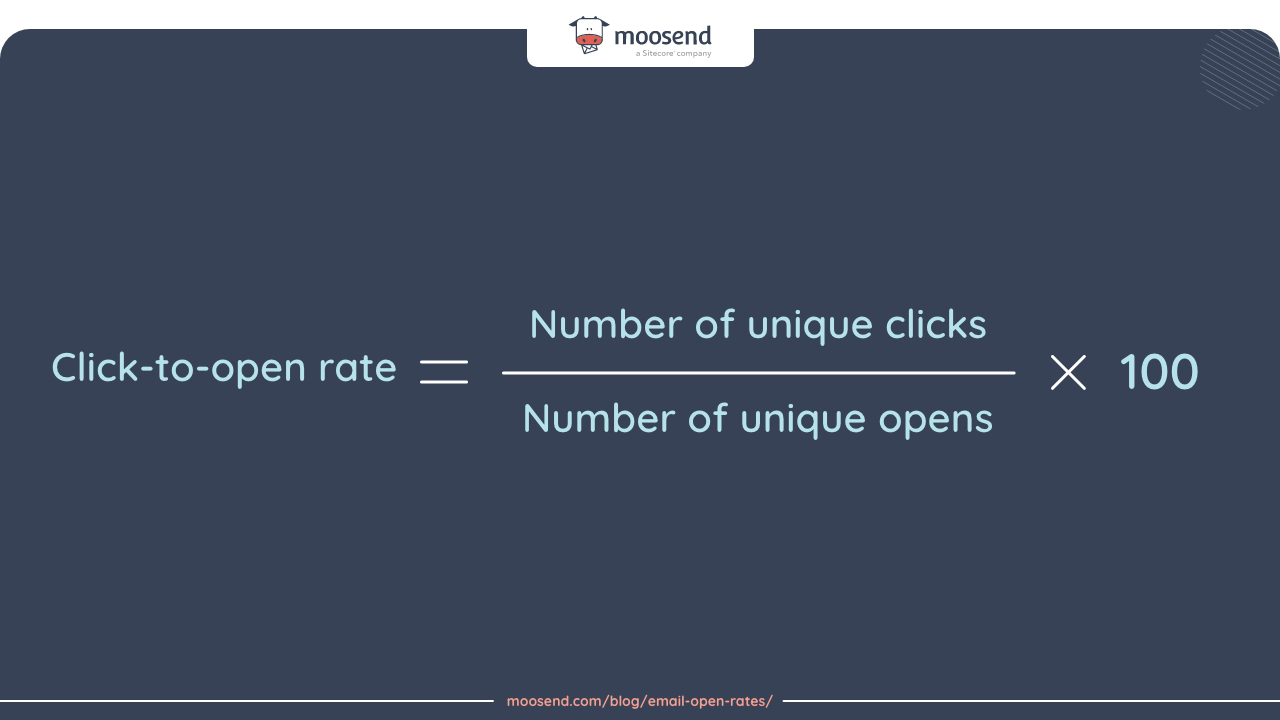
For example, let’s say your recipients opened an email 200 times, and there are 150 clicks.
Dividing 150 by 200 and multiplying it by 100 results in 75%, meaning that that particular email has a high click-to-open rate.
After finding your CTOR, you can create your own benchmark and compare it to internal or average rates across industries.
Click-Through Rate (CTR)
Click-through rate is a marketing metric representing the percentage of people who clicked a link in an email.
This metric indicates how engaging and relevant your campaigns are.
For instance, if your email reaches 100 subscribers but only has ten clicks, it doesn’t resonate well with your target demographic.
In that case, you can try encouraging more email clicks by:
- Providing links throughout the email
- Personalizing the content
- Sending fewer emails with relevant content
Generally, you calculate your email CTR by the number of recipients that clicked at least one link in your emails.
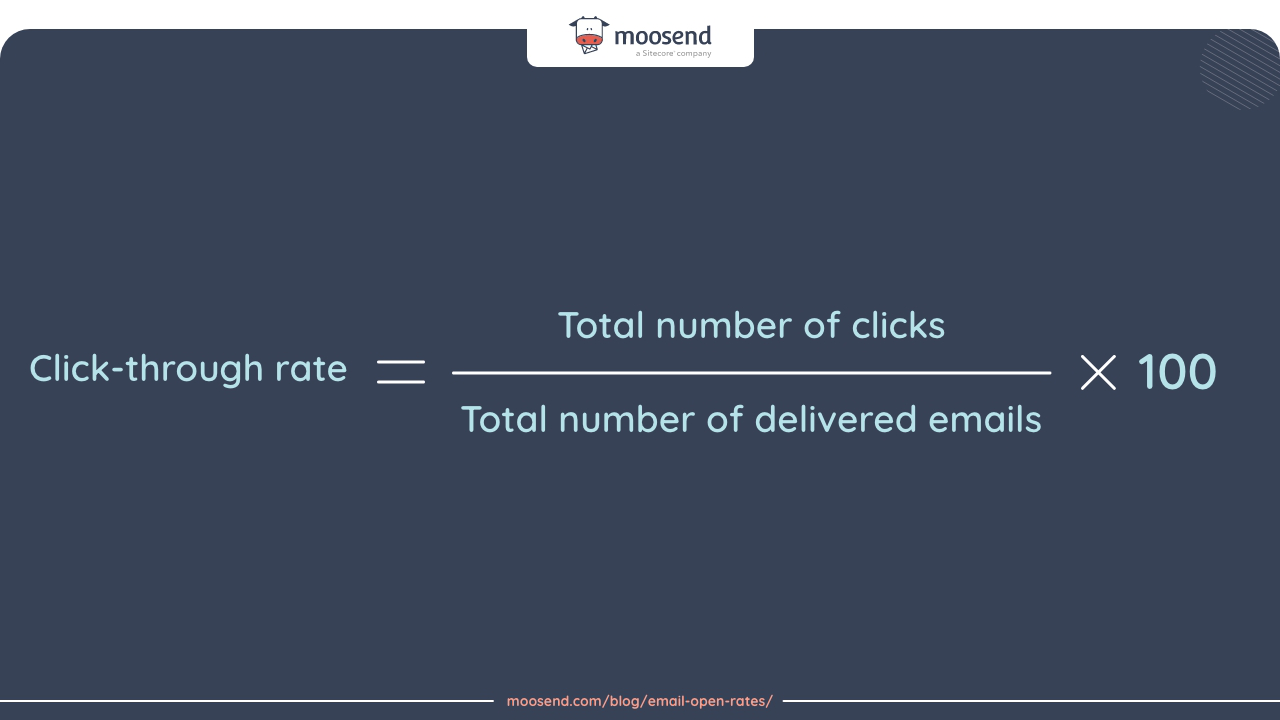
Take the number of people that have clicked a link and divide that by the number of emails you have sent, then multiply it by 100 for a percentage.
Now let’s explore the five key factors that affect open rates.
5 Key Factors Affecting Open Rates
Before you launch any email campaign, you should know the five essential factors affecting your open rates.
Here’s a sneak peek at what will follow:
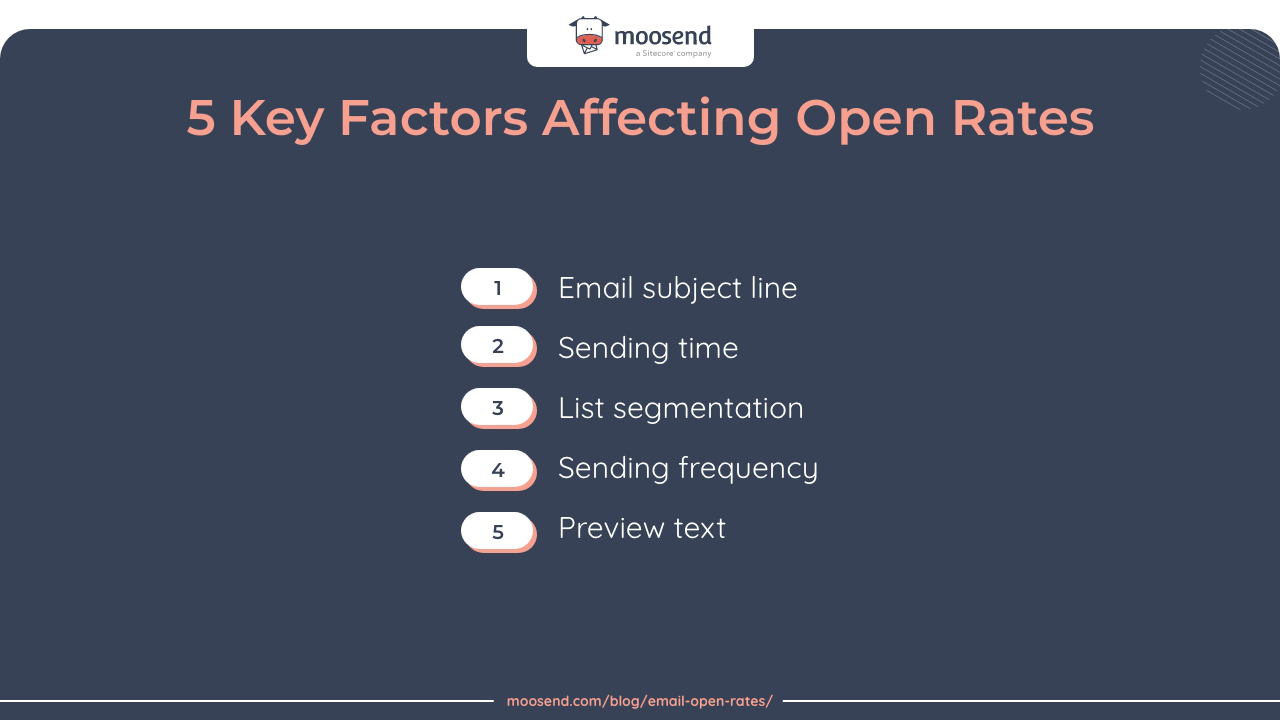
Email subject line
Subject lines are what make or break an email. One look at a subject line, and the recipient will immediately determine whether or not they’ll open the email.
If you have overly long subject lines filled with spammy words that barely fit the screen, your subscribers will likely ignore it.
The secret is keeping them short, concise, and to the point.
Sending time
One crucial factor that affects your open rates is the sending time.
Your clients have a specific time when they check the piles of messages stacked in their inboxes.
So, if you send your emails when the customers are unavailable due to their busy schedules, they probably won’t open them.
To make sure you send emails at an optimal time, you can do the following:
- A/B test sending your emails at different times of the day
- Only test non-time-sensitive emails
List segmentation
A factor often overlooked by marketers is email list segmentation. It filters your email lists based on the client’s interests which highly influence their buying decisions.
In this era of personalization, your content should resonate with your audience; otherwise, you might risk people ignoring your emails and avoiding opening them.
You can start sending the right email to the right audience with Moosend’s marketing segmentation feature.

Our feature lets you use list segmentation to optimize your email marketing campaigns by defining a specific audience subset inside your email lists.
So, if you want to step up your email marketing game, you know who to call.
Sending frequency
Everyone receives emails in their inboxes daily. Sometimes, too many.
As a result, if your clients get five emails a day from you with uninteresting content, they might start ignoring them or simply unsubscribing.
Conversely, if you only send one email in two months, you can miss the chance to interact with your audience, reducing engagement and conversion rates.
Since frequency is an essential factor influencing your open email rates, you must find a balance between what’s too much and what’s too little.
Preview text
Three key elements affect your email marketing metrics: the recipient’s name, the subject line, and the preview text.
The preview text is like an email teaser that appears next to or below your email subject line, clarifying the goal of your campaign—and enticing your readers to open it.
By using compelling words and being brief, you can encourage your clients to click on your email.
With Moosend, adding a preview text is a piece of cake.
All you need to do is start a “New Campaign” and go to “Set Basic Settings.” There, you have a dedicated section to fill in the email preview text, like in the screenshot below:
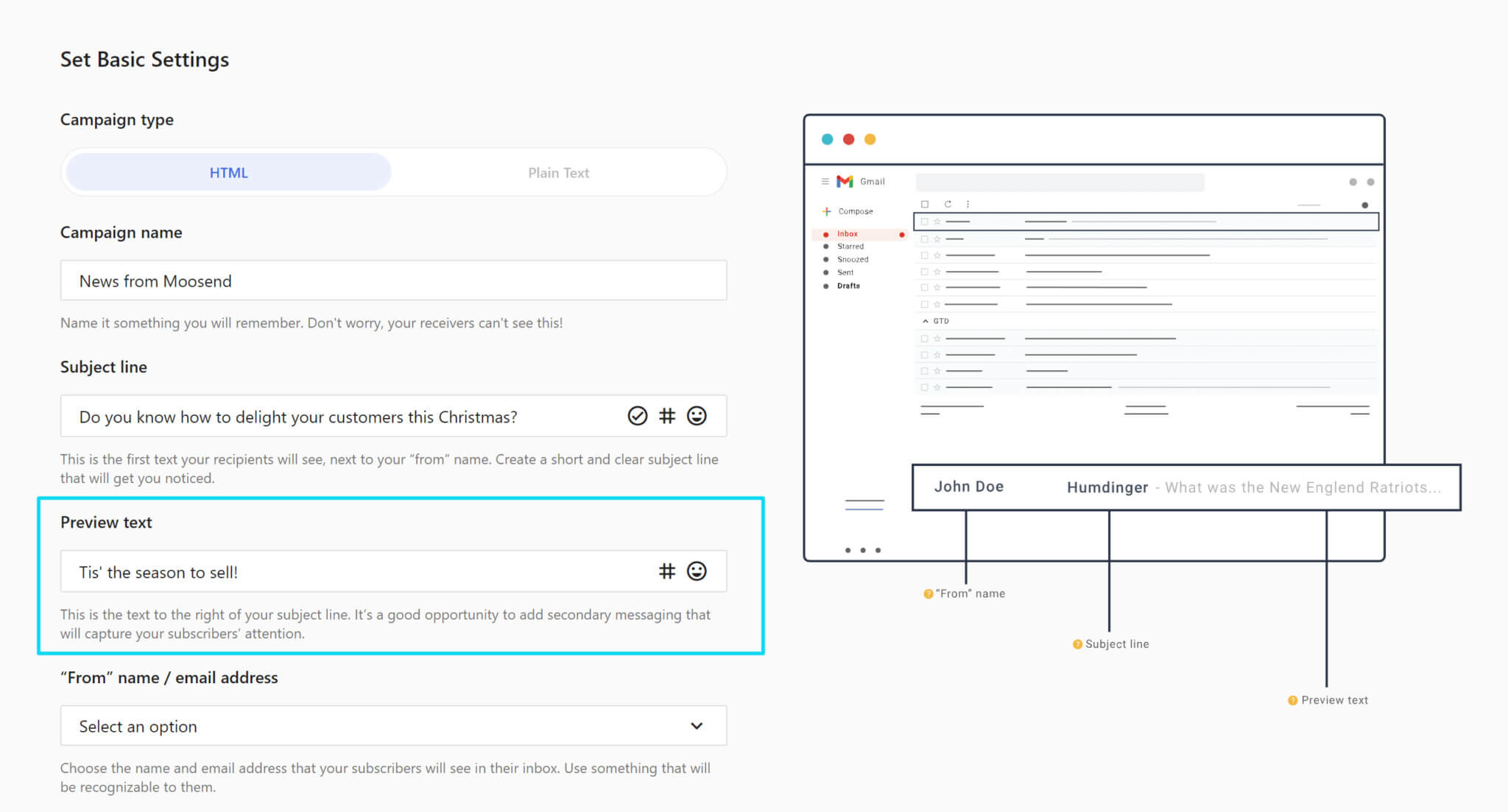
So, if you’re looking for an email marketing automation platform with ready-made email templates and unique features, check out Moosend today.
Moving forward, let’s take a more practical approach to email open rates and see how you can increase them.
Best Practices to Increase Your Email Open Rates
If you’re looking for ways to improve your open rates right now, you’ve come to the right place.
We have the right tips for sending high-quality content to your target audience, leading to more engaged people.
1. Write compelling subject lines
The subject line is the first impression your clients get of you, and amidst the thousands of emails a person receives daily, yours must draw your audience’s attention.
While each business is unique, here are some general guidelines for writing magnetic subject lines:
- Avoid overusing exclamation points and punctuation
- Use power words to elicit emotions
- Draw them in with mystery and suspense
- Personalize the subject line by including the recipient’s name
- Keep your subject lines under ten words and no more than 40–50 characters long
- Use simple and familiar language
While creating effective subject lines isn’t rocket science, sometimes it may be difficult to find the right formula for your audience.
To save time and effort you can use a dedicated subject line tester to help your efforts. These tools will provide you with suggestions and industry averages to ace your creations and open rates.
2. Strategically segment your email list
When you segment your lists, emails are more relevant, which can increase open rates.
In fact, a study found that list segmentation can increase email open rates by 14% more than non-segmented emails.
Here are some tips for personalizing your emails and correctly segmenting them:
- Group subscribers into different categories, such as likes, and dislikes;
- Organize prospects by the content upgrade they opt in for;
- Use behavioral segmentation to send emails based on how people behave on your website.
3. Leverage A/B testing
The best tip is to A/B test everything, from the subject line to email content.
Through A/B testing or spit testing, you can see which subject line resonates better with your specific audience to increase email deliverability rates and check how your emails appear on mobile devices.
Fortunately, with Moosend, you don’t have to second guess which subject line can get more attention.
By simply entering two different texts in the Subject A and Subject B fields, you can test them on a percentage of your email lists, like so:
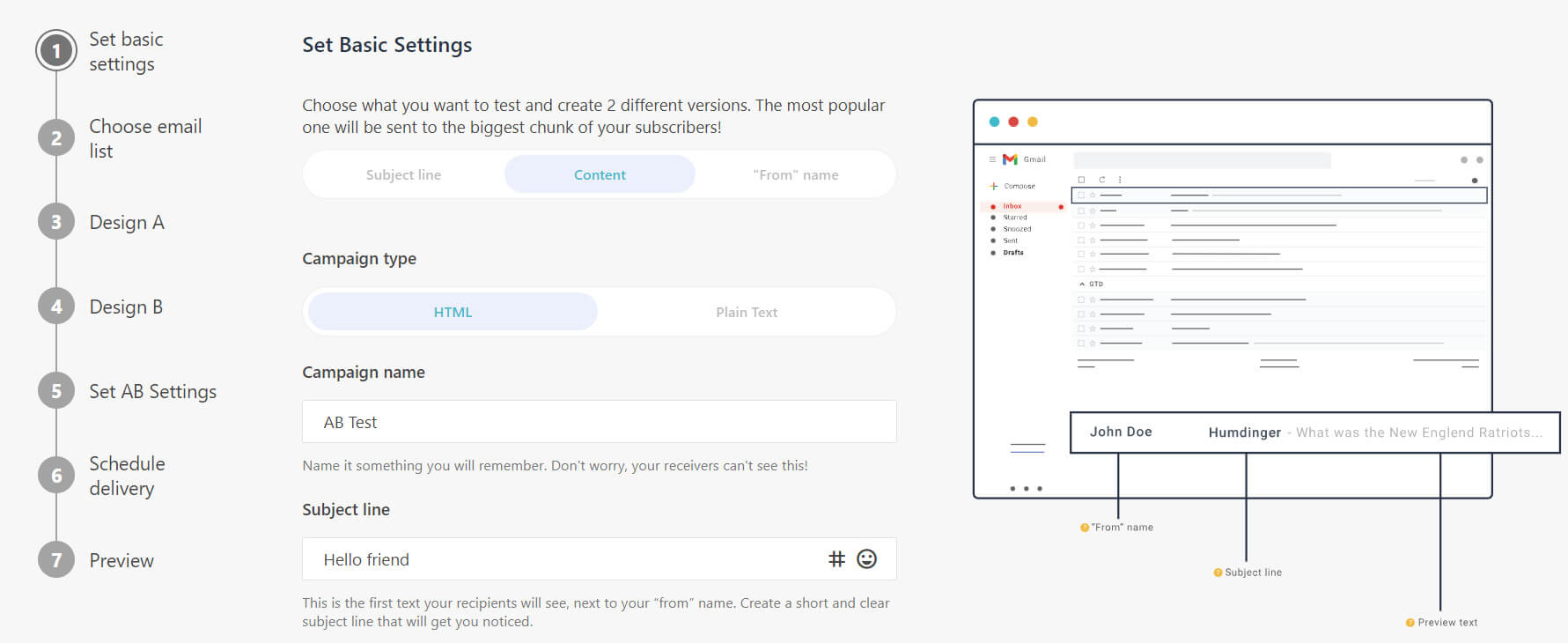
We then dispatch the version that works best to the rest of your recipients.
Thus, you can improve the efficiency of your campaigns by getting to know what catches your recipients’ attention.
4. Send your emails at optimal times
When should you send your emails?
Think about how you operate: do you have a specific time when you check your inbox?
Your customers are likely the same; they also have busy work and personal lives, so you must find the sweet spot where they’re physically and mentally available.
According to data, the best time to send your emails is mid-morning around 10 AM in your recipient’s time zone.
It’s an ideal time because you want to send emails when inboxes are less cluttered and have a higher chance of capturing your audience’s attention.
5. Avoid spam filters
In some cases, your subscribers don’t even get the chance to open your emails because they land in the void called the spam folder.
While you can ask your audience to “whitelist” you, it’s better to avoid certain words that trigger the spam filters of any email service provider, like Google or Outlook.
Pay attention to these red-flag words to beat spam filters, such as:
- Money
- Free
- Click here
- Great offer
- Apply now!
- Winner
- Congratulations
- No gimmicks
- Increase sales
Now Over to You
Every savvy marketer needs to understand how their email marketing campaigns perform.
That’s why knowing the average email open rates by industry, region, and day can help you establish key benchmarks for measuring your performance against your competitors.
As a result, a high email open rate signifies you successfully engaged your audience with your content—which is every business’s dream.
We can help you make your wishes come true and reach new heights by optimizing your email campaigns.
Try Moosend for free now to discover its great features.
The post Email Open Rates By Industry, Region & Day [+ Best Practices] appeared first on Email Marketing Automation Platform for Thriving Businesses.
